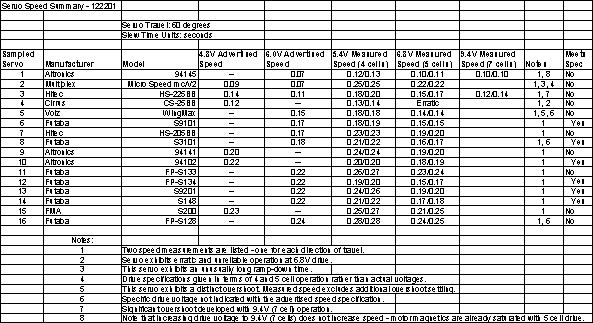Practical Limitations/Considerations and Servo Selection
There are practical system limitations to consider when making airfoil and trim selection choices. Trim selections requiring AOA sensor gains much above 1.5 are problematic. The issue is the wing elevon servo speed. If we stayed awake during “Automatic Control Systems 101” class, we would have learned that servo loop stability is dependent on the gains and the delays in the loop. There is an inverse relationship between the two loop parameters. The larger the loop delay the smaller the loop gain that can be tolerated before loop instability sets in and vise versa. I’ll share the following frustrating experience to shed some light on this issue.
Prior to the summer of 2001 the farthest aft CG I achieved was around 28%. I had hit a brick wall. Any attempts to bring the CG farther aft resulted in loop instability. Up to this point I had primarily used the Hitec HS-225BB servos believing that it was fast enough for the application. Then, by accident, I discovered a deep dark secret about RC servos - the so called “high speed” servos in general don’t meet advertised speed specifications! Some of them don’t even come close!
The way I came to suspect a servo speed problem was when I switched to Nickel-Metal Hydride batteries. I didn’t realize it the time but NiMH batteries have a very high internal resistance compared to Nicads. When I switched to NiMHs it slowed the elevon servos and made the whole system hopelessly unstable. I found this out the hard way - I crashed twice for lack of pitch stability with one of my experimental planks which prior to that point had no problems. That was when I decided to look for the root cause of the instability. I suspected the NiMH batteries somehow might be at fault. This was confirmed when I switched back to Nicads and system stability returned. I then monitored voltage drops for both batteries. Nicads showed a drop around 0.2V while the NiMHs voltage drop was well over a volt. As it turned out the difference was crucial.
I wondered how much the servo speed was effected by use of the NiMHs. I made up a test circuit to measure the servo slew time over large deflection angles. The servo control signal refresh rate was fixed at 50Hz while the pulse width, although centered at 1.5 ms, toggled between programmable minimum and maximum values. The toggle rate was set to 0.5 Hz. The pulse width difference between min and max values was adjusted as necessary to achieve a 60 degree deflection for any servo under test. The no-load slew time was then measured with a scope with the scope probe either attached directly to the internal servo position pot or to an external position sensor. The operation of the external postion sensor operates on the same principle as the magnetic pickup for the AOA sensor. The sensing element was the same 91SS12-2 hall-effect sensor. It sensed the angular position changes of two small magnets attached to the servo arm.
Both approaches gave the same disturbing results - “High Speed” servos don’t come close to meeting the advertised speeds. All servos were driven with 4 and 5 cell subC Nicad packs. Speed measurement results are listed in Table 1 for the 16 servos tested. The fasted servo proved to be the Airtronics 94145 driven with the 5 cell Nicad pack. The advertised speed for this servo is 0.07 seconds with 6 volt drive. The measured speed was 0.1 seconds with the 5 cell Nicad (6.8V) - significantly below specification.
I contacted three manufacturers about this issue including Futaba, Airtronics, and Hitec. Only Hitec bothered to answer at all but the respondent never provided an answer as to why the servos don’t meet the speed specifications.
I didn’t bother changing out servos in the Albatross I but the obvious conclusion is to use the Airtronics 94145 servo unless an even faster one with sufficient torque is found.
Servo Speed Measurements Excel Worksheet - 18 KB

Table 1 Servo Speed Measurements - Results Summary